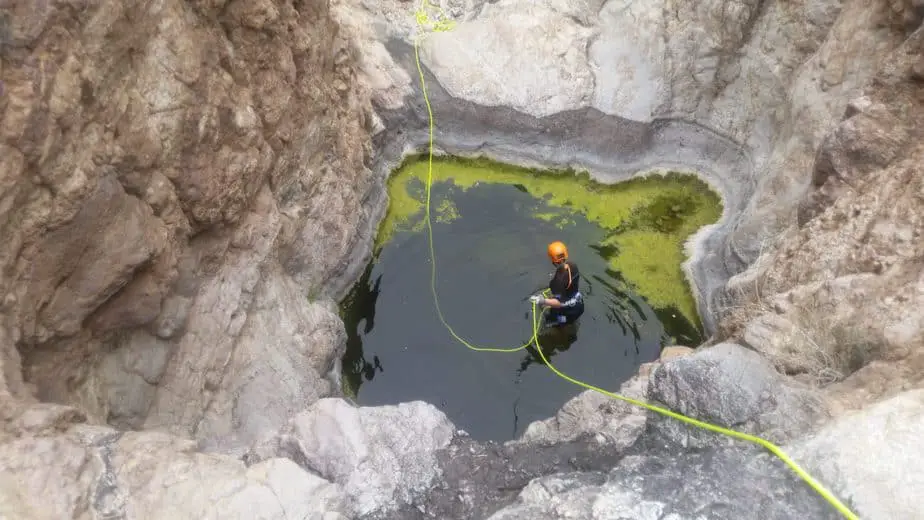One of the most treacherous aspects of canyoneering, and one that can be nearly impossible to plan for, is the existence of Potholes, or Keeper Holes. Unless you are doing a well-trafficked canyon in a National Park (and even then it could be a problem), there is no way of knowing for sure the condition of any potholes that may require special skills to escape from. It is crucial to learn and practice these techniques for when you inevitably come across a dangerous situation.
6 Techniques for Escaping a Pothole or Keeper Hole
- Climbing
- Partner Assist
- Pack Toss
- Flotation
- Hooking
- Catcher Sticks
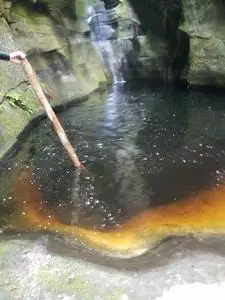
What is a Pothole, or Keeper Hole?
Keeper holes are usually found in sandstone slot canyons. The potholes are formed by falling water at the bottom of any drop in water flow. When the canyons are full of water, in early spring or right after a flash flood, you can usually swim across the top of the hole.
Later in the summer or fall, as water evaporates and is absorbed into the rock, deep potholes dry up and can become almost inescapable. Sometimes the water dries up completely, leaving a steep, smooth-surfaced wall to be scaled, and other times the water remains too deep for you to touch the bottom, forcing you to tread water until you find a way out. You can go through the same canyon multiple times over the years, and never find the water levels the same. What was once a swimmer and waterfall slide can easily turn into a deep pit during certain seasons.
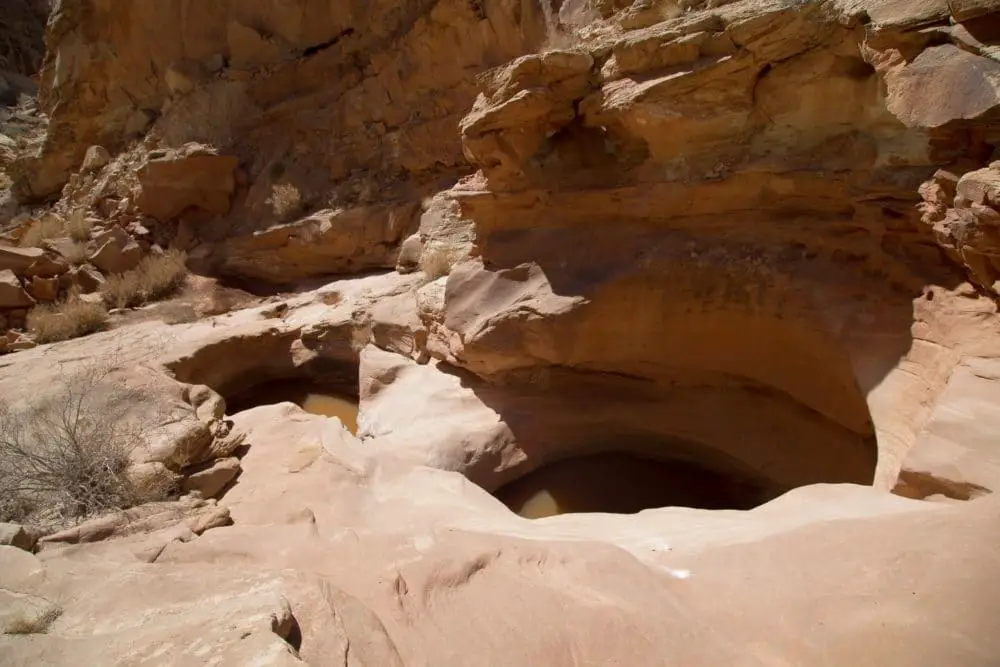
The main goal in escaping a keeper pothole is to get one person out. Once that person is out, he or she can create an anchor and lower a rope for everyone else. In many instances, a simple deadman’s anchor will offer plenty of resistance for the other canyoneers to climb out. For a deadman’s anchor, tie the rope around yourself or into your harness and then lie down on the ground and brace yourself. You become the anchor that allows everyone else to escape the hole.
Climbing
The walls of keeper potholes are usually really smooth, making it difficult for an average person to climb out of. Bring a climber along! Climbers can solve some of the more difficult problems that seem impossible to the untrained eye. A seemingly featureless face may have just enough small divots or friction for a climber to find a way out. A strong climber will know how to smear the sandstone and get as much grip as possible.
Another technique that works in dry keeper holes is to attempt to run up the side of the pothole, or run around the side while moving upwards. Sandstone, while lacking cracks and shelves for climbing, is usually very coarse and grippy.
It’s important to have the right shoes with excellent grip so you don’t slip. Some shoes completely lose their purchase when they get wet, so make sure the shoes you have are adequate. I’ve written a complete guide to the best shoes for canyoneering. There are some awesome shoes out there, and most can be used for hiking and other outdoors activities. Check out the article here- What are the Best Canyoneering Shoes?
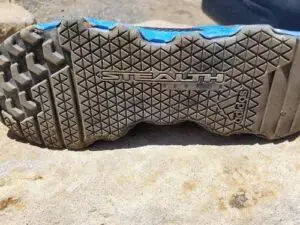
Partner Assist
If one person can’t make it up, try adding another one to the mix. The easiest technique is to kneel down on one knee and have the climber stand on your other knee. This gives an extra 24 inches of height. If extra height is needed, from this position you can lean into the rock and have the climber step onto your shoulder. Slowly stand up, leaning as far into the rock as possible. Once fully extended, you can take one of the climber’s feet in both hands and lift up even further (think cheerleaders).
Hopefully the human ladder of 10 feet you’ve built is enough to clear the obstacle. Obviously, adding more people to the picture is ideal. Multiple people can create a sort of human pyramid, but be very careful in case the climber falls. Someone should always stand by the side to catch the climber if he or she falls. Different gymnastic and cheerleading techniques for lifting and throwing the lightest person may come in handy (again, always have a spotter). Select the climber in the group for this task, and preferably the lightest-weight person.
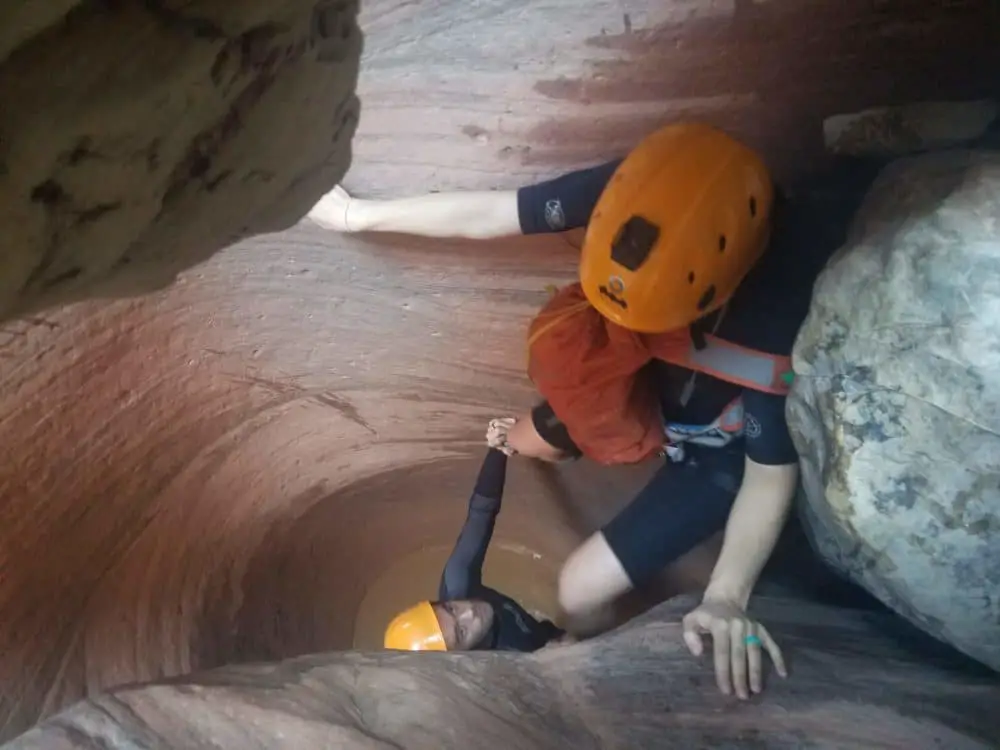
Partner assists work very well to escape a keeper pothole, but they also can prove useful for getting the last person into the pothole. With no nearby anchors, the last person may have to use a thigh belay or a meat anchor to lower everyone else down by rope. In order to descend, the rest of the group can use these partner assist techniques to arrest the last person’s fall. Two people at the base should execute a pyramid capture by catching the feet and lowering the person while bracing him or her against the rock face.
These techniques will work as long as you can touch the ground; however, oftentimes potholes are deep enough when full that you have to tread water (in that case, getting in is easy!). Sure, someone can try to stand under water and still execute a partner assist, but there are other ways of escaping that aren’t as risky (canyon sludge and canyon stew are not fun to soak in).
Any time you are climbing or lifting each other, you need to have a helmet on. I wrote a little bit about the helmets we use due to their low pricing and safety, which you can read in our Recommended Gear Guide .
.
Pack Toss
If you can’t get out using basic climbing techniques or with the help of a partner or two, then the next step is to toss a weighted pack over the ledge. In some situations, a rope bag or backpack works, but in others you may need to supplement the weight with sand or mud. Be careful if you fill the bag all the way full, because it may burst upon impact with the ground.
To execute a pack toss, use a figure 8 to tie the rope to the outside of the bag (or tie the 8 to a carabiner and clip onto the bag). Leave plenty of rope so you can hold the end and toss the pack. You will get the furthest distance by swinging the bag underhand. It’s a lot easier to toss the pack from the top, prior to dropping into the pothole, especially when there’s water involved.
Toss the pack as far back as you can and then drag it towards you until it catches on something. You may have to try this several times until it is secure. Once it’s secure, the lightest person can ascend the rope hand over hand, or with the use of ascension gear.
Imlay Canyon Gear makes a pack specific for getting out of keepers, called the Potshot . Rather than using the weight of gear or the rope, they are designed to be filled with sand for added weight. Simply tie a rope to the handles and launch the bag out over the lip of the pothole, then reel it back in until it catches. The bag is reinforced with additional straps to prevent a blowout after high impact tosses.
. Rather than using the weight of gear or the rope, they are designed to be filled with sand for added weight. Simply tie a rope to the handles and launch the bag out over the lip of the pothole, then reel it back in until it catches. The bag is reinforced with additional straps to prevent a blowout after high impact tosses.
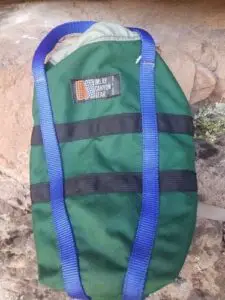
Another option that works with limited success is to toss a rope with a hook or set of hooks on the end (like Batman’s grappling hook). This works well if you can toss the rope into a log jam, but the hooks may otherwise damage the canyon.
Take a look at our Recommended Gear Page for a list of the backpacks that we use that work well for canyoning.
for a list of the backpacks that we use that work well for canyoning.
Flotation
One technique you can use in deep water is to rig a couple of floating packs together (packs with dry bags in them), or bring along an inflatable raft. The climber then hoists him or herself up onto the raft and climbs out of the hole. The climber can use the pack straps as footholds. A second swimmer can push against the raft to keep it from jettisoning away from the wall as the climber exits the hole.
Hooking
Some canyoneers bring along hooks (such as the Petzl Reglette or Black Diamond Talon
or Black Diamond Talon used in aid climbing) attached to poles. This technique may scar and damage the rock, and should be left as a last resort. Most canyons that require this already have holes drilled into the rock. There used to be a tool specifically designed for canyoneering called the “Happy Hooker” (be careful googling that!), that had a similar purpose. Again, this should be used as a last resort only. The canyon guidebook or beta should tell you if hooking is required.
used in aid climbing) attached to poles. This technique may scar and damage the rock, and should be left as a last resort. Most canyons that require this already have holes drilled into the rock. There used to be a tool specifically designed for canyoneering called the “Happy Hooker” (be careful googling that!), that had a similar purpose. Again, this should be used as a last resort only. The canyon guidebook or beta should tell you if hooking is required.
Catcher Sticks
A giant log can be a lot of help. I list it last here, because you can’t exactly bring one with you! There are two options for using a catcher stick. The first is to use it as a ladder. Lean the log up against the lip of the pothole, and dig the base into the sand or mud (or have a partner secure the base). Climb up the log and then help the others out.
The other option which can be used in some situations, is to find a log wide enough to stem across the canyon, tie a rope to it, and toss it over the lip of the pothole until it snags. Then climb the rope just as in a pack toss. Remember that it is virtually impossible to throw anything while treading water, so throw before you rappel if that’s the case.
Obviously, this could only be used in certain situations, but it brings up the point that the best tool you can use to escape a keeper pothole is your creativity. Odds are, other people have come through the canyon and (unless they’re still there!) have found ways out.
Safety Tips for Keeper Potholes:
Never pull the rappel rope until at least one person has exited the pothole. There’s a reason you often find dead animals floating in the bottom of keeper holes.
Do not spend a significant amount of time treading water. If plan ‘A’ fails, ascend the rope, warm up, and make a new plan. Hypothermia will lead to drowning, and you’ll need all of your strength to escape.
If descending a canyon for the first time as exploration, consider going through backwards and rigging a rope to the keeper holes.

